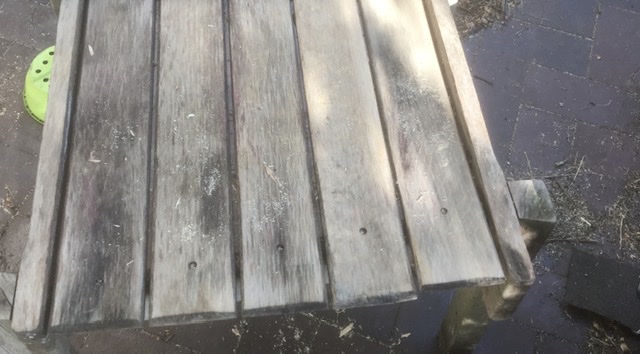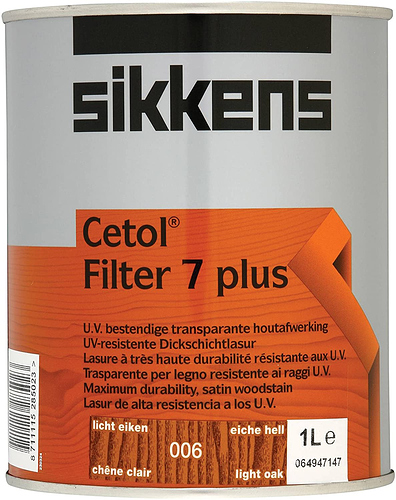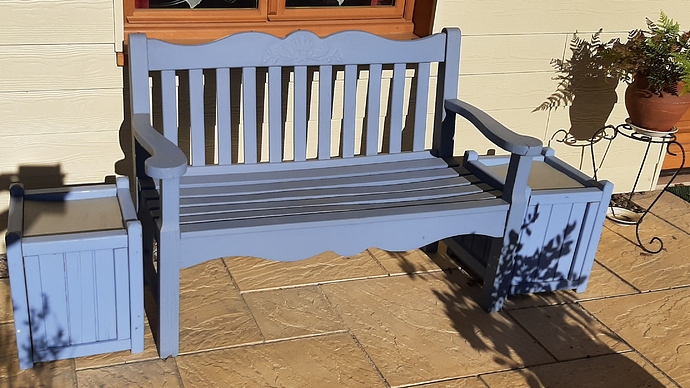Hi
I’m looking to renovate some wooden chairs which have been kicking around the garden for a couple of years. They are structurally sound, with no obvious signs of rot. I’ve started sanding and (hopefully) you can see the before and after pictures. I think the wood might be elm? Anyway, do I keep sanding until all the black bits have gone and the wood is white, or is what I have done as good as it gets? We’re not yet settled on how to finish them -Cuprinol Paint, Creocote or some sort of outside varnish; suggestions welcome.


I spent a chunk at the start of the confinement sorting out my shutters. I only have three pairs and although they are all made of the the same wood two pairs were were treated with lasure and the others with marine varnish. I started with the worst pair which had lasure. I took them back to bare wood then treated them with teak oil but used up my whole supply in the process. As the bricos were all shut and the other two pairs weren’t in too bad condition, I repainted them with the same as they had had before, using up the last of my lasure at the same time. I much prefer the look of the ones treated with teak oil and sometime in the future will strip the other two pairs and treat them the same way. While I was in this DIY streak I used a linseed oil thinned in turpentine to refresh my wooden garden furniture, that looked really good afterwards as well.
We’re just about to start a reno job on our oak window sills and we have bought this product which we have already used on a handrail leading down to the drive…
They use it on the wood pergola in Chasseneuil-sur-Bonnieure and it’s very effective and waterproof (which is where we got the idea from). There is a range of colours, we have used chéne clair (clear oak) but there are other colours. https://www.sikkens.fr/fr/produits/sikkens/cetol-filter-7-plus
We also renovated an old oak 2 seater bench which had been left out under a tree for a number of years and was in a sodden state. We left it in the garage to dry out for a couple of weeks, sanded it down and then painted it. Looks fabulous now on our “blue terrace”…
We had HUGE problems with ants when we used linseed oil - they loved it! Maybe we should have added turpentine?
That looks fabulous! Well done! What was the paint you used? I have a metal ended bench in dire condition but all the paint in my barn, even if outdoor, says ‘not for horizontal wood’.
Turps is fab and i’m sure will keep the ants away!
I agree with David on this one. A 50 / 50 mix of Linseed Oil and Turpentine works really well and both products are cheaply available in 1 litre bottles at our local supermarket. Just wipe the mixture on with a cloth, leave to dry for 48 hrs, and the polish with a soft clean dry cloth.
Another advantage is that there is little need for any preparation other than washing the dirt off first when you need to re-do it in future years.
Hi Robert
Just to be clear, is that artists‘ turpentine or turpentine substitute that you mix with the Linseed Oil? (Loving this thread, it’s turning into The Repair Shop!)
There is another product that you’re supposed to add to the mix. I will go and find the bottle later so I can share the name. It’s a good, cheap way of protecting and improving the look of many wooden items.
It can be mineral turpentine (white spirit) or terebenthine (organic turpentine), or a mixture of both. Doesn’t really matter, make your own recipe and try it out. Never use undiluted linseed oil - takes forever to dry and doesn’t penetrate the wood very well.
no wonder I spent ages treating my hockey stick… ![]()
![]()
It was 5 years ago and it was probably bought from Le Clerc but sadly cannot now find the tin so we probably used it all up or the remaining contents dried up. Sorry. We think the colour might have been called Charente Bleu and may have been intended for shutters…
Thanks! (I never knew white spirit was turpentine substitute
This is fascinating . When we were looking to renovate the surface of a brick floor, the builder recommended boiled linseed oil as it dried much faster - he had also used it on encaustic tiles.
“Jennings, what do bats do in the Winter?”
Linseed oil can be used to refresh sun faded black trim on cars too!
If you are considering painting them you need to sand any grey looking wood back to the original finish or whichever paint you decide to use will not not take or last longterm. Teak oil is a good finsh or an alternative is Tung Oil.
is that where the expression “give it a lick [of paint]” comes from? ![]()
Hi Franz,
It’s best to use the real stuff when it comes to the turpentine. You’ll find it in the supermarket cleaning products section under the name of "Essence a la terebenthine’’.
Hello All
This is just to thank everyone for their helpful advice yesterday - lots of ideas to work on. (But I still don’t know what bats do in the Winter…!)
Treating exterior woodwork can sometimes take on the appearance of a religion and everyone has their beliefs. I was always a subscriber to the oiling sect but never really happy with the results - looks good for a short while (but is sticky to sit on for almost as long) and by the end of the season you are almost back to square one. Like many, I assumed this was the way it had to be.
Somehow I stumbled on some discussion of alternatives and decided to try something different this year, in the hope that I can break the chain. A little more effort first time round, but hopefully much easier going forwards and a better finish to boot. I was also convinced by the argument in some articles that oiling exotic woods like teak is actually damaging to the wood rather then restorative
First step is to use teak cleaner and renovator - I ordered Wessex products delivered from the UK and was amazed by the cleaner in particular - just wet the wood and then use diluted cleaner with a coarse sponge and the blackness and any crud just melt away. A quick hose over to rinse it off and it is almost good enough to give the coat, although the removator and a light sanding also benefit.
And then a few coats of a marine sealer - the most highly recommended is a US made brand called SEMCO which is also available online. Not cheap, but I reckon I will need very little in future to top up the seal maybe every 2 years.
Of course I didn’t read all of this until after I had coated my table with oil and getting it cleaned again afterwards is something of a task - in fact the table is still waiting in the sun for it to finally wash out - I will know that is done when light sandpaper doesn’t immediately gum up!

